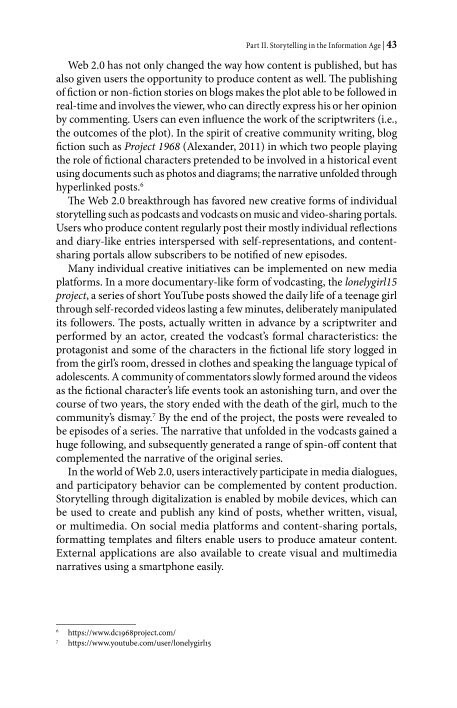

OCR
Part II. Storytelling in the Information Age | 43 Web 2.0 has not only changed the way how content is published, but has also given users the opportunity to produce content as well. The publishing offiction or non-fiction stories on blogs makes the plot able to be followed in real-time and involves the viewer, who can directly express his or her opinion by commenting. Users can even influence the work of the scriptwriters (i.e., the outcomes of the plot). In the spirit of creative community writing, blog fiction such as Project 1968 (Alexander, 2011) in which two people playing the role of fictional characters pretended to be involved in a historical event using documents such as photos and diagrams; the narrative unfolded through hyperlinked posts." The Web 2.0 breakthrough has favored new creative forms of individual storytelling such as podcasts and vodcasts on music and video-sharing portals. Users who produce content regularly post their mostly individual reflections and diary-like entries interspersed with self-representations, and contentsharing portals allow subscribers to be notified of new episodes. Many individual creative initiatives can be implemented on new media platforms. In a more documentary-like form of vodcasting, the lonelygirl15 project, a series of short YouTube posts showed the daily life of a teenage girl through self-recorded videos lasting a few minutes, deliberately manipulated its followers. The posts, actually written in advance by a scriptwriter and performed by an actor, created the vodcast’s formal characteristics: the protagonist and some of the characters in the fictional life story logged in from the girl’s room, dressed in clothes and speaking the language typical of adolescents. A community of commentators slowly formed around the videos as the fictional character’s life events took an astonishing turn, and over the course of two years, the story ended with the death of the girl, much to the community's dismay.’ By the end of the project, the posts were revealed to be episodes of a series. The narrative that unfolded in the vodcasts gained a huge following, and subsequently generated a range of spin-off content that complemented the narrative of the original series. In the world of Web 2.0, users interactively participate in media dialogues, and participatory behavior can be complemented by content production. Storytelling through digitalization is enabled by mobile devices, which can be used to create and publish any kind of posts, whether written, visual, or multimedia. On social media platforms and content-sharing portals, formatting templates and filters enable users to produce amateur content. External applications are also available to create visual and multimedia narratives using a smartphone easily. 6 https://www.dc1968project.com/ 7 https://www.youtube.com/user/lonelygirhis
Strukturell
Custom
Image Metadata
- Bild Breite
- 1831 px
- Bild Höhe
- 2835 px
- Bild Auflösung
- 300 px/inch
- Dateigröße
- 1.26 MB
- Permalink zum JPG
- 022_000040/0043.jpg
- Permalink zur OCR
- 022_000040/0043.ocr
Benutzeranmeldung
Deutschde
